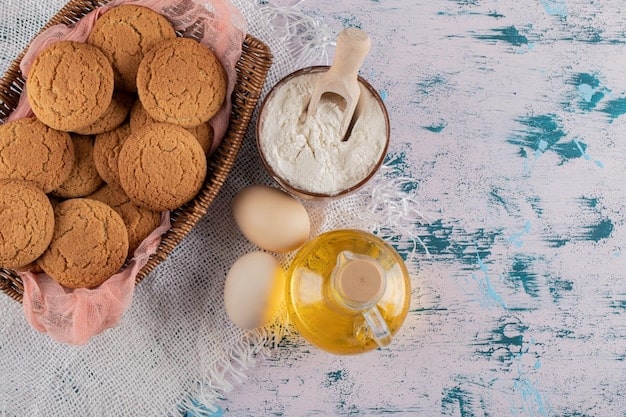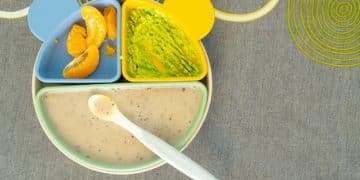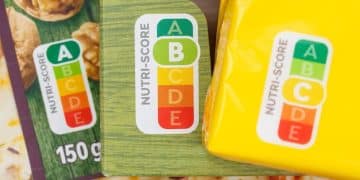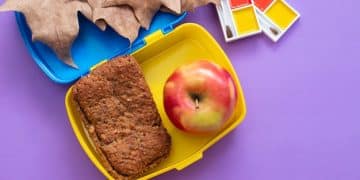Allergy-Friendly Baking: Gluten-Free & Dairy-Free Treats for Kids

Allergy-friendly baking offers delicious and safe alternatives for children with gluten and dairy sensitivities, allowing them to enjoy treats without triggering allergic reactions through thoughtful ingredient substitutions and creative recipes.
Navigating the world of childhood allergies can be challenging, especially when it comes to treats. But fear not! Allergy-friendly baking: delicious gluten-free and dairy-free treats your kids will love is entirely possible, bringing joy back to snack time without compromising their health.
Understanding Common Allergies in Children
Food allergies are increasingly common in children, making it crucial to understand the most prevalent ones and their implications. Recognizing common allergies is the first step toward creating safe and enjoyable treats for everyone.
Gluten Intolerance and Celiac Disease
Gluten intolerance and celiac disease require strict dietary management. Understanding the differences and symptoms is crucial for accommodating children with these conditions.
Dairy Allergies and Lactose Intolerance
Dairy allergies and lactose intolerance are also widespread among kids. Learning to identify alternatives and read labels is essential for avoiding potential reactions.
- Recognize the symptoms of gluten intolerance and celiac disease.
- Identify dairy-free substitutes like almond milk, coconut milk, and oat milk.
- Read food labels carefully to avoid cross-contamination.
- Consult with a pediatrician or allergist for accurate diagnoses and recommendations.
By understanding these common allergies, parents and caregivers can make informed decisions and create safe, delicious, and inclusive baking experiences for all children.
Essential Ingredients for Allergy-Friendly Baking
Creating allergy-friendly baked goods requires a shift in ingredients. Luckily, there are a plethora of alternatives that work beautifully and maintain the flavor and texture of traditional recipes.
Gluten-Free Flour Blends
Gluten-free flour blends are the backbone of gluten-free baking. Experimenting with different blends can help you achieve the perfect texture in your treats.
Dairy-Free Milk and Butter Substitutes
Dairy-free milk and butter substitutes provide the moisture and fat needed for successful baking. From almond milk to coconut oil, there are many options to explore.
- Use a blend of rice flour, tapioca starch, and potato starch for a versatile gluten-free flour blend.
- Opt for plant-based milks like almond, soy, or oat to replace dairy milk.
- Coconut oil, vegan butter sticks, and avocado oil are excellent substitutes for butter.
- Consider using applesauce or mashed banana to add moisture and sweetness.

With the right ingredients on hand, you can confidently tackle allergy-friendly baking and create delectable treats that everyone can enjoy.
Delicious Gluten-Free Recipes
Gluten-free baking doesn’t have to mean sacrificing flavor or texture. These recipes show how to create mouthwatering treats that are both safe and satisfying.
Gluten-Free Chocolate Chip Cookies
Everyone loves chocolate chip cookies, and this gluten-free version is no exception. With the right flour blend, you can achieve that classic chewy texture.
Gluten-Free Banana Bread
Banana bread is a comforting classic that can easily be made gluten-free. Using ripe bananas and a touch of cinnamon adds natural sweetness and warmth.
These two recipes are just the tip of the iceberg when it comes to gluten-free delights. With a little creativity, you can adapt many of your favorite recipes to be gluten-free.
Creative Dairy-Free Baking Ideas
Dairy-free baking opens up a world of possibilities. These ideas showcase how to create rich and flavorful treats without any dairy products.
Dairy-Free Chocolate Cake
Chocolate cake is a crowd-pleaser, and it’s surprisingly easy to make dairy-free. Using coconut milk or coffee can enhance the chocolate flavor.
Dairy-Free Lemon Bars
Lemon bars offer a refreshing and tangy alternative to heavier desserts. Dairy-free butter substitutes work perfectly to create a rich, buttery crust.
- Use full-fat coconut milk for a rich and creamy dairy-free frosting.
- Experiment with dairy-free chocolate chips and cocoa powder for intense chocolate flavor.
- Add citrus zest to your recipes for a burst of fresh flavor.
- Consider using aquafaba (chickpea brine) as an egg replacer for vegan baking.
Dairy-free baking can be just as decadent and satisfying as traditional baking, as these recipes perfectly show.
Adapting Family Favorite Recipes
One of the biggest challenges of allergy-friendly baking is adapting family favorite recipes. With a few simple swaps, you can transform your go-to recipes into allergy-friendly delights.
Tips for Swapping Ingredients
Knowing how to swap ingredients effectively is key to successful allergy-friendly baking. Start with small changes and adjust as needed to achieve the perfect result.
Maintaining Flavor and Texture
Maintaining flavor and texture is crucial when adapting recipes. Using the right substitutes and adjusting baking times can help you achieve the desired outcome.

Transforming your family favorites into allergy-friendly versions allows everyone to enjoy the same beloved recipes, tailored to their dietary needs.
Tips for Success in Allergy-Friendly Baking
Allergy-friendly baking can be a rewarding experience with these tricks. From careful ingredient selection to proper preparation, these tips will set you up for success.
Reading Labels Carefully
Reading labels carefully is essential to avoid cross-contamination and hidden allergens. Always double-check ingredient lists to ensure they meet your needs.
Preventing Cross-Contamination
Preventing cross-contamination is vital for those with severe allergies. Use separate utensils, baking pans, and cutting boards to minimize the risk.
- Store allergy-friendly ingredients separately from other foods to prevent cross-contamination.
- Clean your baking equipment thoroughly before each use.
- Use parchment paper to line baking pans and prevent direct contact with surfaces that may contain allergens.
- Be mindful of shared appliances like toasters and ovens.
By following these tips, you can confidently navigate allergy-friendly baking and create safe, delicious treats for your loved ones.
| Key Point | Brief Description |
|---|---|
| ✅ Gluten-Free Baking | Use gluten-free flour blends for cookies and breads. |
| 🥛 Dairy-Free Alternatives | Replace dairy with almond, soy, or coconut milk. |
| ⚠️ Read Labels | Carefully check labels to avoid hidden allergens. |
| 👩🍳 Baking Tips | Prevent cross-contamination with separate tools. |
Frequently Asked Questions
▼
Common gluten-free flour alternatives include rice flour, almond flour, tapioca flour, and potato starch. These can be used individually or in blends for optimal results.
▼
You can replace dairy with plant-based milks like almond, soy, or coconut milk. Vegan butter substitutes and coconut oil are great for replacing butter in recipes.
▼
Preventing cross-contamination involves using separate utensils, baking pans, and cutting boards. Always clean your equipment thoroughly and store allergen-free ingredients separately.
▼
Naturally sweet alternatives to sugar include agave nectar, maple syrup, honey, and fruit purees like applesauce or mashed bananas, adding both sweetness and moisture.
▼
Start by swapping out common allergens like gluten and dairy with suitable alternatives. Small adjustments to liquid amounts or baking times may be needed for best results.
Conclusion
Allergy-friendly baking: delicious gluten-free and dairy-free treats your kids will love is not only possible, but can also be a fun and creative culinary adventure. By understanding common allergies, using the right ingredients, and following simple tips, you can create a range of delectable treats that everyone can safely enjoy. Bake on!





